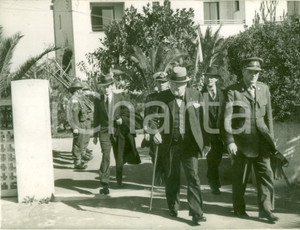
1939 USA WW2 Lindbergh & Roosevelt on Nazi Armaments
€60,00
(Risparmi
)
Charles Lindbergh meets President Roosvelt
Photo shows Mr. Charles Lindbergh leaving the White House after a meeting with President Roosevelt. Lindbergh made several visits in Germany between 1936 and 1939 trying to gather informations on developments in aviation and Nazi armaments and it was during these meetings that he used to report his impressions to Mr. Roosevelt.
Because of his trips to Nazi Germany, combined with a belief in eugenics, Lindbergh was suspected of being a Nazi sympathizer.
Lindbergh had been an outspoken advocate of keeping the U.S. out of the world conflict and proposed that the United States negotiate a neutrality pact with Germany. In 1941 President Roosevelt publicly criticized Lindbergh's views on neutrality and compared him to U.S. Rep. Clement L. Vallandigham (D-OH), the leader of the "Copperhead" movement that had opposed the American Civil War. Three days later the famed aviator resigned his commission as a Colonel in the U.S. Army Air Corps.
Fotografia d'epoca raffigurante il famoso aviatore mentre esce da una riunione alla Casa Bianca con il Presidente Roosevelt. Lindebergh compi' diversi viaggi in Germania (tra il 1936 e il 1939) nel tentativo di raccogliere informazioni sullo stato dell'aviazione e degli armamenti nazisti. A causa di questi viaggi molti ritennero che fosse un simpatizzante del regime nazista e un ammiratore di Adolf Hitler.
Certamente Lindbergh si impegnò assiduamente affinchè gli Stati Uniti non entrassero in guerra a fianco degli alleati europei e affinchè trattassero una pace separata con la Germania.
Per questo motivo, pochi anni dopo (nel 1941), fu aspramente criticato da Roosevelt e per questo motivo rassegnò le proprie dimissioni dal grado di Colonnello dell'aviazione militare statunitense.
Foto Agenzia Giornalistica VEDO - Roma
Vera fotografia d'epoca, originale e autentica, completa di timbro datario e di nota dattiloscritta al verso (in lingua francese).
L'immagine versa in ottime condizioni.
---------------------------
Note: Charles Augustus Lindbergh (February 4, 1902 - August 26, 1974) (nicknamed "Slim," "Lucky Lindy" and "The Lone Eagle") was an American aviator, author, inventor, explorer, and social activist.
Lindbergh, then a 25-year old U.S. Air Mail pilot, emerged from virtual obscurity to almost instantaneous world fame as the result of his Orteig Prize-winning solo non-stop flight on May 20-21, 1927, from Roosevelt Field located in Garden City on New York's Long Island to Le Bourget Field in Paris, France, a distance of nearly 3,600 statute miles (5,800 km), in the single-seat, single-engine monoplane Spirit of St. Louis. Lindbergh, a U.S. Army reserve officer, was also awarded the nation's highest military decoration, the Medal of Honor, for his historic exploit.
In the late 1920s and early 1930s, Lindbergh relentlessly used his fame to help promote the rapid development of U.S. commercial aviation. In March 1932, however, his infant son, Charles, Jr., was kidnapped and murdered in what was soon dubbed the "Crime of the Century" which eventually led to the Lindbergh family fleeing the United States in December 1935 to live in Europe where they remained until the surprise attack on Pearl Harbor by the Imperial Japanese Navy. Before the United States formally entered World War II by declaring war on Japan on December 8, 1941, Lindbergh had been an outspoken advocate of keeping the U.S. out of the world conflict, as was his Congressman father, Charles August Lindbergh (R-MN), during World War I, and became a leader of the anti-war America First movement. Nonetheless, he supported the war effort after Pearl Harbor and flew many combat missions in the Pacific Theater of World War II as a civilian consultant, even though President Franklin D. Roosevelt had refused to reinstate his Army Air Corps colonel's commission that he had resigned in April 1941.







